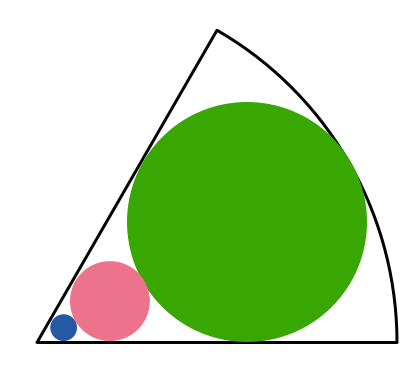Circulisious

Given a sector of radius 10 and angle , we draw the largest circle (in green) that is tangent to all sides of the sector. We then draw the circle (in pink) that is tangent to the 2 sides, and also to the green circle. We repeat this process indefinately, where the next circle is shown in blue.
Find the sum of the areas of these infinitely many circles.
This section requires Javascript.
You are seeing this because something didn't load right. We suggest you, (a) try
refreshing the page, (b) enabling javascript if it is disabled on your browser and,
finally, (c)
loading the
non-javascript version of this page
. We're sorry about the hassle.
r 1 r 2 r 3 = = = ⋮ 2 1 ( 1 0 − r 1 ) ⇒ r 1 = 3 1 0 2 1 ( 1 0 − ( 2 r 1 + r 2 ) ) ⇒ r 2 = 9 1 0 2 1 ( 1 0 − ( 2 r 1 + 2 r 2 + r 3 ) ) ⇒ r 3 = 2 7 1 0
Sum of these areas form a geometric progression sum :
1 0 0 π [ ( 3 1 ) 2 + ( 9 1 ) 2 + ( 2 7 1 ) 2 + ⋯ ] = 8 1 0 0 π = 2 2 5 π .